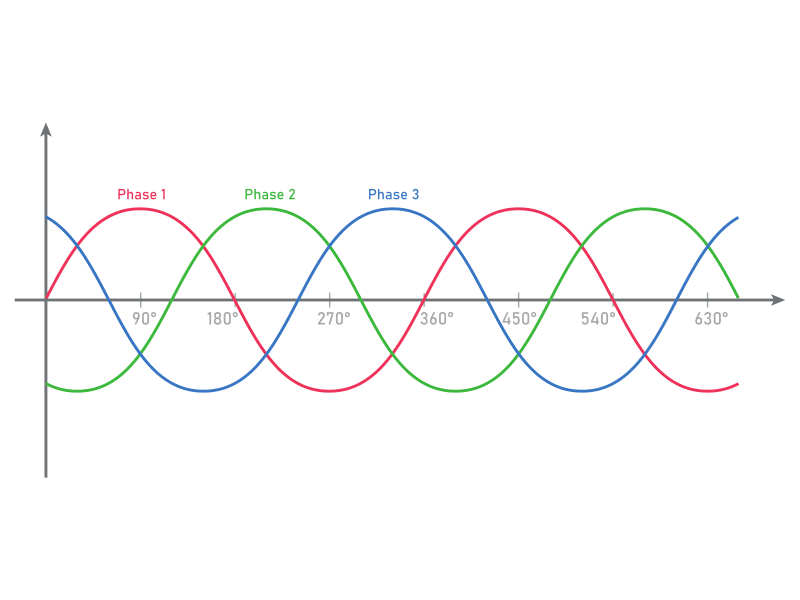
Why the Electricity Grid is Predominantly Three-Phase?
The electricity grid, the vast network of power generation, transmission, and distribution that powers our modern world, is predominantly designed around a three-phase system. This ubiquitous configuration has become the global standard, with good reason. Delving into the technical and historical factors that have solidified three-phase as the preferred choice offers valuable insights into the inner workings of our electrical infrastructure.
The Advantages of Three-Phase Power
Efficient Power Transmission
At the core of the three-phase system’s appeal is its efficiency in power transmission. Compared to single-phase systems, three-phase allows for the use of fewer conductors to transmit the same amount of power. This translates to substantial savings in copper and other materials, making the infrastructure more cost-effective to build and maintain.
Smoother, More Reliable Motor Operation
Three-phase power also brings significant advantages in electric motor performance. Motors powered by three-phase supplies can start and run in a predetermined direction, unlike single-phase motors that may require complex mechanisms to ensure directional control. Furthermore, three-phase motors operate with a constant power output, eliminating the pulsations and vibrations that can plague single-phase designs.
Balanced Load Distribution
The symmetrical nature of three-phase systems ensures an even distribution of the electrical load across all three phases. This balanced load helps to minimize issues like voltage imbalances and uneven current draw, which can lead to inefficiencies and potential equipment damage in single-phase setups.
Read More: What is Power Quality, Why is it Important?
Historical Factors in the Adoption of Three-Phase
The Influence of Nikola Tesla
The widespread adoption of three-phase power can be traced back to the pioneering work of Nikola Tesla, the renowned electrical engineer and inventor. Tesla’s groundbreaking designs for three-phase induction motors and generators laid the foundation for the technology’s dominance in the late 19th and early 20th centuries.
The War of the Currents
The so-called “War of the Currents” between proponents of direct current (DC) and alternating current (AC) power systems in the late 1800s also played a role in the rise of three-phase. AC systems, championed by Tesla and George Westinghouse, ultimately prevailed over Thomas Edison’s DC-based approach, in part due to the inherent advantages of three-phase AC for long-distance power transmission.
Standardization and Global Adoption
As the electrical grid expanded globally, the three-phase system emerged as the de facto standard, thanks to its technical merits and the widespread adoption by major power utilities and equipment manufacturers. This standardization has helped to drive economies of scale and ensure compatibility across the international electrical infrastructure.
Read More: What is Gas Insulated Switchgear?
Limitations of Three-Phase Power
Complexity in Wiring and Equipment
While three-phase power offers numerous benefits, it also introduces a higher level of complexity compared to single-phase systems. The additional wiring requirements and the specialized equipment needed, such as three-phase motors and transformers, can increase the overall cost and installation complexity of three-phase systems.
Challenges in Smaller-Scale Applications
In smaller-scale applications, such as residential or light commercial settings, the advantages of three-phase power may not always outweigh the added complexity and cost. In these scenarios, single-phase systems often remain the more practical and cost-effective choice.
Read More: Harmonic Filters | The Key to a Healthy Power Grid
Alternatives and Emerging Trends
Higher-Order Polyphase Systems
Although three-phase remains the dominant standard, there are instances where higher-order polyphase systems, such as six-phase or twelve-phase, are employed. These configurations can offer benefits like reduced harmonic distortion and improved power quality, particularly in large-scale industrial or high-voltage applications.
Distributed Generation and Renewable Integration
As the global energy landscape evolves, with the increasing adoption of distributed generation and renewable energy sources, the role of three-phase power may continue to evolve. Emerging technologies, such as microgrids and smart grid systems, may introduce new challenges and opportunities for the three-phase framework.
The widespread use of three-phase power in the electricity grid is a testament to its technical advantages and the historical factors that have solidified its position as the global standard. While alternative configurations may emerge for specialized applications, the three-phase system’s efficiency, reliability, and compatibility have made it an enduring choice for powering the modern world’s electrical infrastructure. As the grid continues to transform, the three-phase approach remains a cornerstone of our electrical systems, adapting and evolving to meet the ever-changing demands of our energy-hungry society.


